E124 Business Law: Legal Frameworks, Impacts, and Solutions
VerifiedAdded on 2024/04/25
|18
|5205
|158
Report
AI Summary
This assignment provides a comprehensive analysis of business law, focusing on the English legal system's structure and various sources of laws that organizations must comply with. It explains the role of government in law-making, differentiating between statutory and common law applications in justice courts. The report details employers' legal obligations regarding occupational health and safety, workers' compensation, harassment, and equal opportunities. Furthermore, it examines the impact of employment and contract law on businesses, using a case study to illustrate potential legal problems. The assignment suggests and justifies legal solutions for these problems, assessing their positive and negative impacts. It concludes with recommendations on appropriate legal solutions, considering alternative dispute resolution processes and comparing the effectiveness of different legal frameworks, including a brief exploration of accident prevention strategies and relevant employment laws.
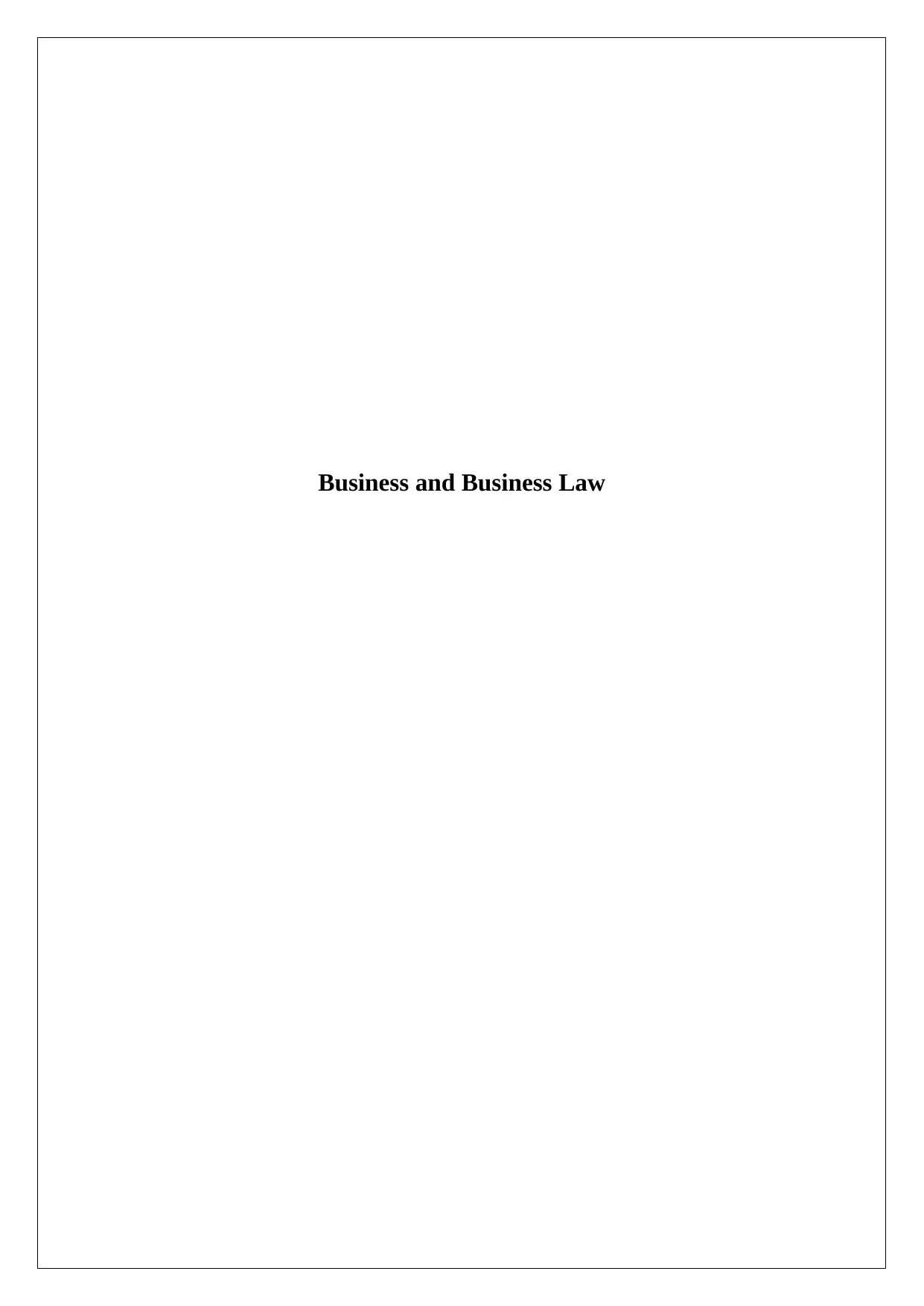
Business and Business Law
Paraphrase This Document
Need a fresh take? Get an instant paraphrase of this document with our AI Paraphraser
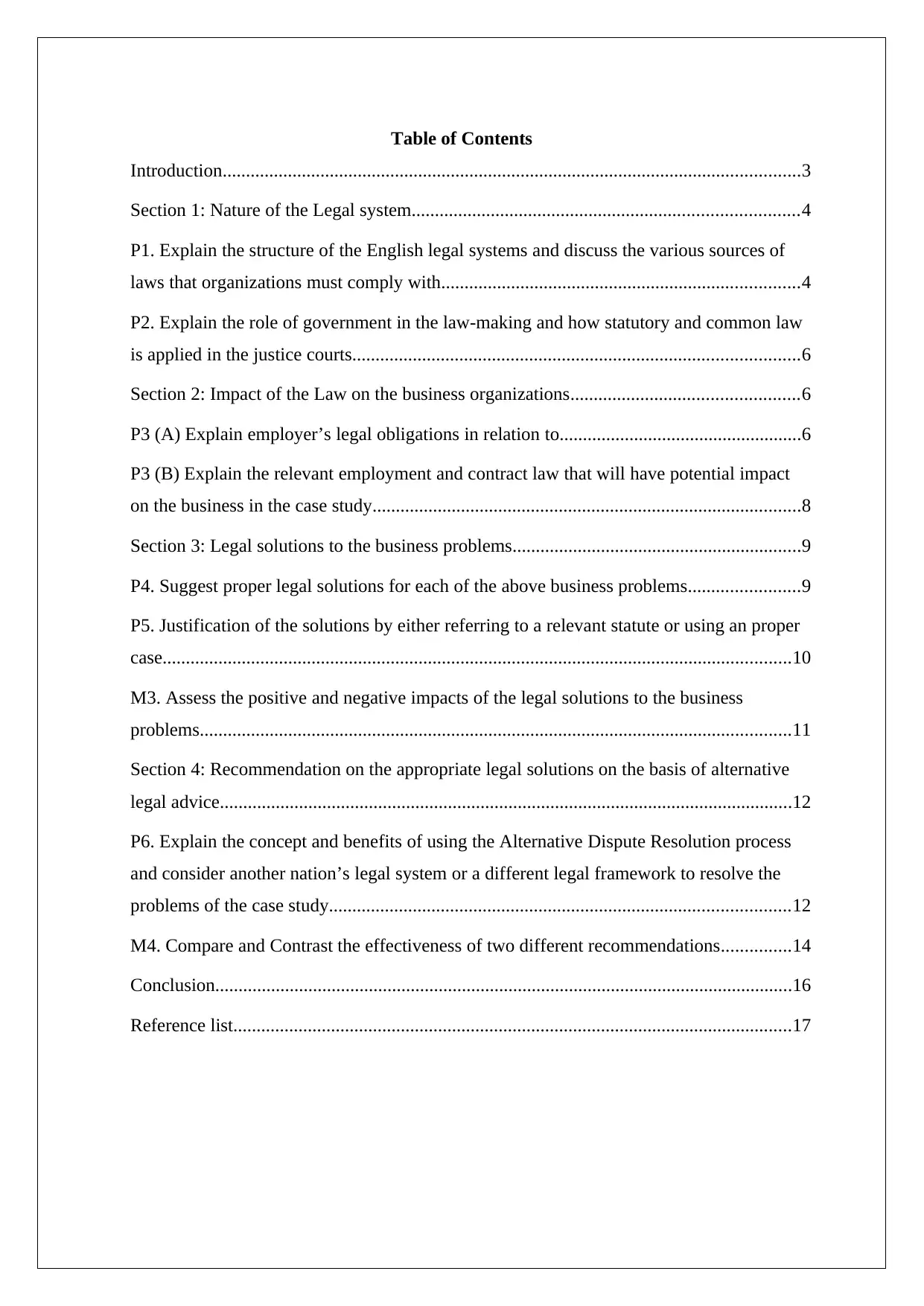
Table of Contents
Introduction............................................................................................................................3
Section 1: Nature of the Legal system...................................................................................4
P1. Explain the structure of the English legal systems and discuss the various sources of
laws that organizations must comply with.............................................................................4
P2. Explain the role of government in the law-making and how statutory and common law
is applied in the justice courts................................................................................................6
Section 2: Impact of the Law on the business organizations.................................................6
P3 (A) Explain employer’s legal obligations in relation to....................................................6
P3 (B) Explain the relevant employment and contract law that will have potential impact
on the business in the case study............................................................................................8
Section 3: Legal solutions to the business problems..............................................................9
P4. Suggest proper legal solutions for each of the above business problems........................9
P5. Justification of the solutions by either referring to a relevant statute or using an proper
case.......................................................................................................................................10
M3. Assess the positive and negative impacts of the legal solutions to the business
problems...............................................................................................................................11
Section 4: Recommendation on the appropriate legal solutions on the basis of alternative
legal advice...........................................................................................................................12
P6. Explain the concept and benefits of using the Alternative Dispute Resolution process
and consider another nation’s legal system or a different legal framework to resolve the
problems of the case study...................................................................................................12
M4. Compare and Contrast the effectiveness of two different recommendations...............14
Conclusion............................................................................................................................16
Reference list........................................................................................................................17
Introduction............................................................................................................................3
Section 1: Nature of the Legal system...................................................................................4
P1. Explain the structure of the English legal systems and discuss the various sources of
laws that organizations must comply with.............................................................................4
P2. Explain the role of government in the law-making and how statutory and common law
is applied in the justice courts................................................................................................6
Section 2: Impact of the Law on the business organizations.................................................6
P3 (A) Explain employer’s legal obligations in relation to....................................................6
P3 (B) Explain the relevant employment and contract law that will have potential impact
on the business in the case study............................................................................................8
Section 3: Legal solutions to the business problems..............................................................9
P4. Suggest proper legal solutions for each of the above business problems........................9
P5. Justification of the solutions by either referring to a relevant statute or using an proper
case.......................................................................................................................................10
M3. Assess the positive and negative impacts of the legal solutions to the business
problems...............................................................................................................................11
Section 4: Recommendation on the appropriate legal solutions on the basis of alternative
legal advice...........................................................................................................................12
P6. Explain the concept and benefits of using the Alternative Dispute Resolution process
and consider another nation’s legal system or a different legal framework to resolve the
problems of the case study...................................................................................................12
M4. Compare and Contrast the effectiveness of two different recommendations...............14
Conclusion............................................................................................................................16
Reference list........................................................................................................................17

Introduction
This assignment is about different business law as it explained structure of English legal
frameworks and discussed different sources about laws which organizations should apply for
better working system. Every organisation has responsibility for their employees as the
procedures of health and safety assist to improve the overall productivity of the organisation.
This assignment also briefly explained the legal obligations related to the worker
compensation, harassment and others. In order to build a global organization, owners can
have different disputes between them. Here in this assignment different solution also been
analysed in order to solve those issues.
This assignment is about different business law as it explained structure of English legal
frameworks and discussed different sources about laws which organizations should apply for
better working system. Every organisation has responsibility for their employees as the
procedures of health and safety assist to improve the overall productivity of the organisation.
This assignment also briefly explained the legal obligations related to the worker
compensation, harassment and others. In order to build a global organization, owners can
have different disputes between them. Here in this assignment different solution also been
analysed in order to solve those issues.
⊘ This is a preview!⊘
Do you want full access?
Subscribe today to unlock all pages.

Trusted by 1+ million students worldwide
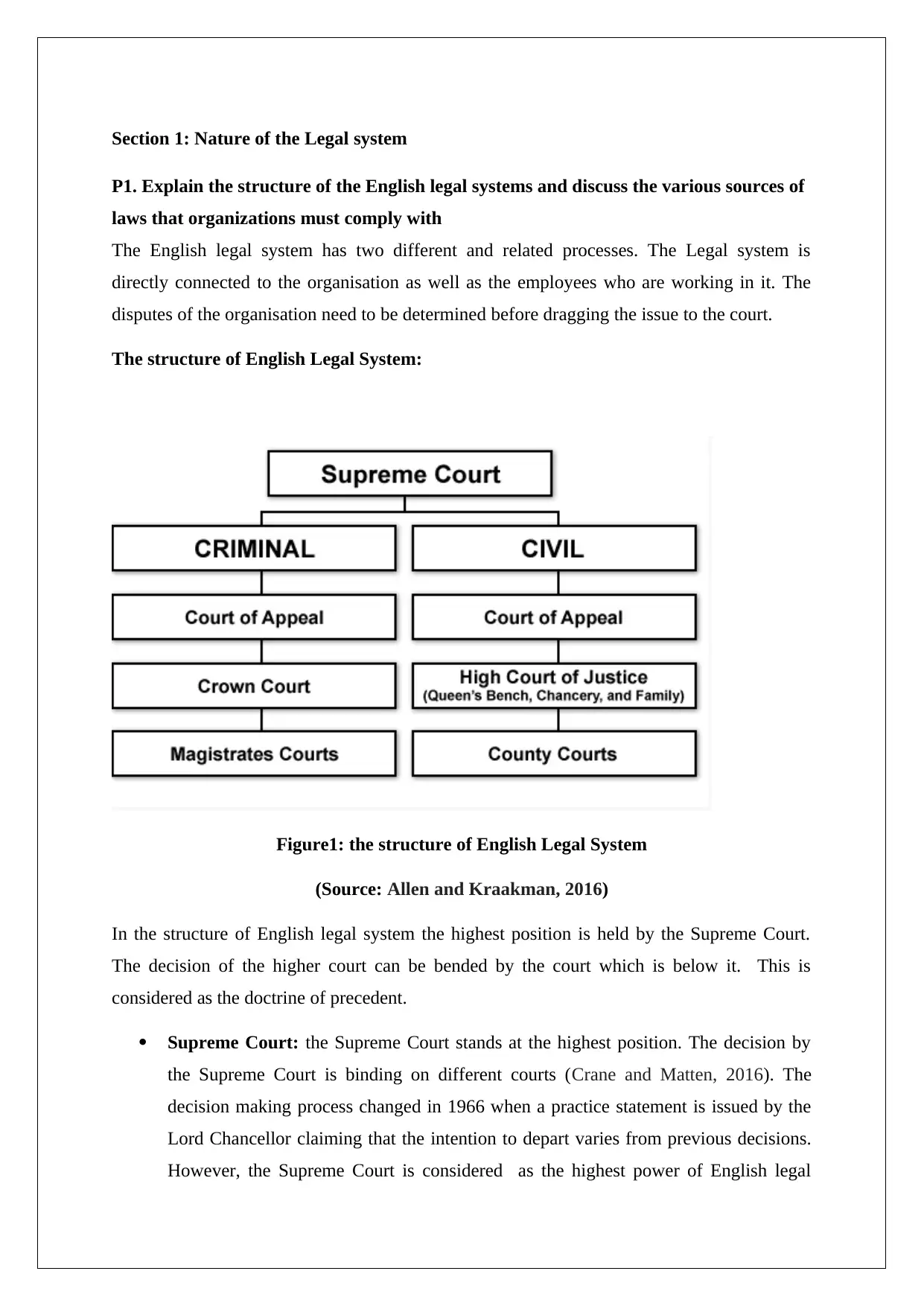
Section 1: Nature of the Legal system
P1. Explain the structure of the English legal systems and discuss the various sources of
laws that organizations must comply with
The English legal system has two different and related processes. The Legal system is
directly connected to the organisation as well as the employees who are working in it. The
disputes of the organisation need to be determined before dragging the issue to the court.
The structure of English Legal System:
Figure1: the structure of English Legal System
(Source: Allen and Kraakman, 2016)
In the structure of English legal system the highest position is held by the Supreme Court.
The decision of the higher court can be bended by the court which is below it. This is
considered as the doctrine of precedent.
Supreme Court: the Supreme Court stands at the highest position. The decision by
the Supreme Court is binding on different courts (Crane and Matten, 2016). The
decision making process changed in 1966 when a practice statement is issued by the
Lord Chancellor claiming that the intention to depart varies from previous decisions.
However, the Supreme Court is considered as the highest power of English legal
P1. Explain the structure of the English legal systems and discuss the various sources of
laws that organizations must comply with
The English legal system has two different and related processes. The Legal system is
directly connected to the organisation as well as the employees who are working in it. The
disputes of the organisation need to be determined before dragging the issue to the court.
The structure of English Legal System:
Figure1: the structure of English Legal System
(Source: Allen and Kraakman, 2016)
In the structure of English legal system the highest position is held by the Supreme Court.
The decision of the higher court can be bended by the court which is below it. This is
considered as the doctrine of precedent.
Supreme Court: the Supreme Court stands at the highest position. The decision by
the Supreme Court is binding on different courts (Crane and Matten, 2016). The
decision making process changed in 1966 when a practice statement is issued by the
Lord Chancellor claiming that the intention to depart varies from previous decisions.
However, the Supreme Court is considered as the highest power of English legal
Paraphrase This Document
Need a fresh take? Get an instant paraphrase of this document with our AI Paraphraser
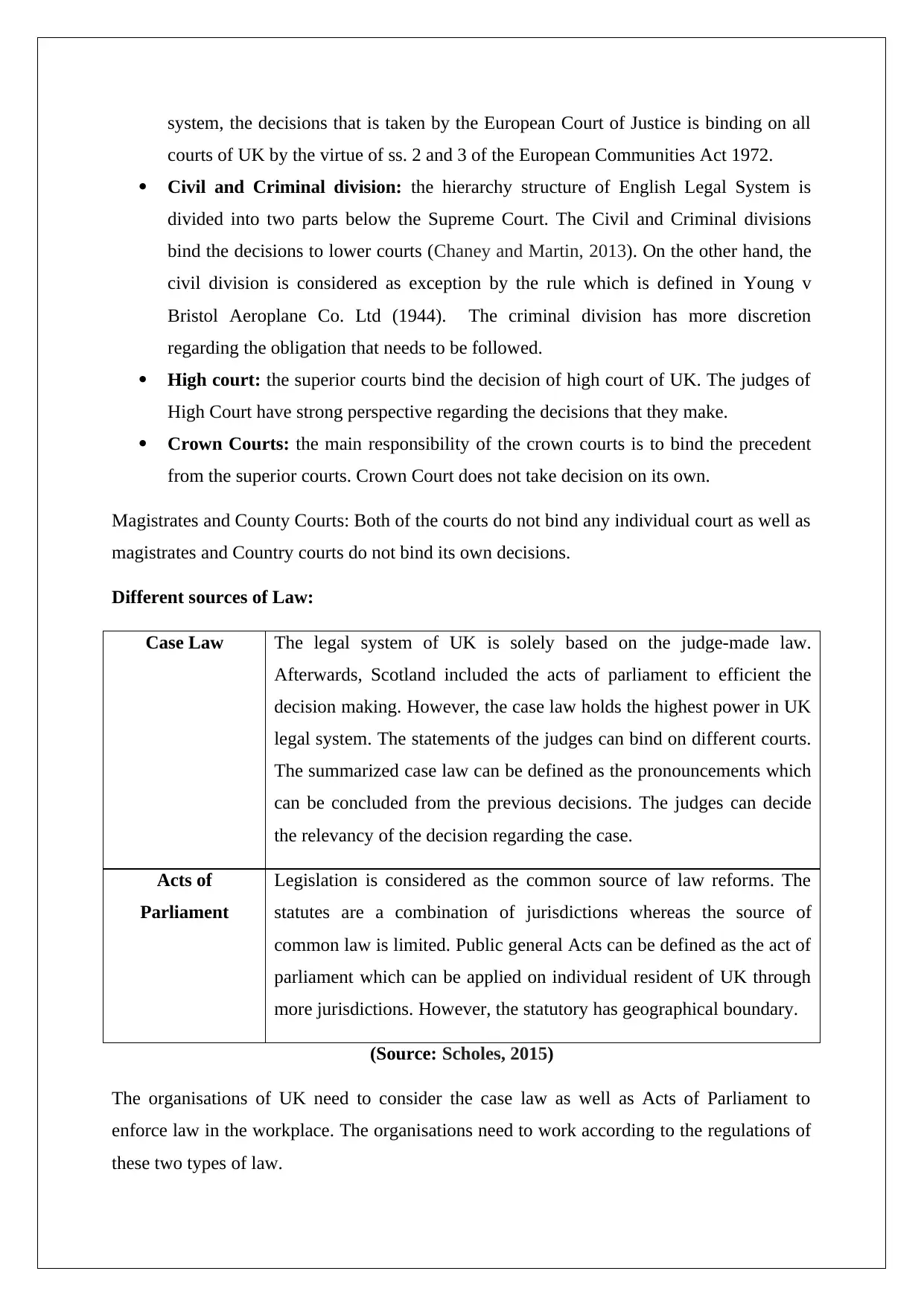
system, the decisions that is taken by the European Court of Justice is binding on all
courts of UK by the virtue of ss. 2 and 3 of the European Communities Act 1972.
Civil and Criminal division: the hierarchy structure of English Legal System is
divided into two parts below the Supreme Court. The Civil and Criminal divisions
bind the decisions to lower courts (Chaney and Martin, 2013). On the other hand, the
civil division is considered as exception by the rule which is defined in Young v
Bristol Aeroplane Co. Ltd (1944). The criminal division has more discretion
regarding the obligation that needs to be followed.
High court: the superior courts bind the decision of high court of UK. The judges of
High Court have strong perspective regarding the decisions that they make.
Crown Courts: the main responsibility of the crown courts is to bind the precedent
from the superior courts. Crown Court does not take decision on its own.
Magistrates and County Courts: Both of the courts do not bind any individual court as well as
magistrates and Country courts do not bind its own decisions.
Different sources of Law:
Case Law The legal system of UK is solely based on the judge-made law.
Afterwards, Scotland included the acts of parliament to efficient the
decision making. However, the case law holds the highest power in UK
legal system. The statements of the judges can bind on different courts.
The summarized case law can be defined as the pronouncements which
can be concluded from the previous decisions. The judges can decide
the relevancy of the decision regarding the case.
Acts of
Parliament
Legislation is considered as the common source of law reforms. The
statutes are a combination of jurisdictions whereas the source of
common law is limited. Public general Acts can be defined as the act of
parliament which can be applied on individual resident of UK through
more jurisdictions. However, the statutory has geographical boundary.
(Source: Scholes, 2015)
The organisations of UK need to consider the case law as well as Acts of Parliament to
enforce law in the workplace. The organisations need to work according to the regulations of
these two types of law.
courts of UK by the virtue of ss. 2 and 3 of the European Communities Act 1972.
Civil and Criminal division: the hierarchy structure of English Legal System is
divided into two parts below the Supreme Court. The Civil and Criminal divisions
bind the decisions to lower courts (Chaney and Martin, 2013). On the other hand, the
civil division is considered as exception by the rule which is defined in Young v
Bristol Aeroplane Co. Ltd (1944). The criminal division has more discretion
regarding the obligation that needs to be followed.
High court: the superior courts bind the decision of high court of UK. The judges of
High Court have strong perspective regarding the decisions that they make.
Crown Courts: the main responsibility of the crown courts is to bind the precedent
from the superior courts. Crown Court does not take decision on its own.
Magistrates and County Courts: Both of the courts do not bind any individual court as well as
magistrates and Country courts do not bind its own decisions.
Different sources of Law:
Case Law The legal system of UK is solely based on the judge-made law.
Afterwards, Scotland included the acts of parliament to efficient the
decision making. However, the case law holds the highest power in UK
legal system. The statements of the judges can bind on different courts.
The summarized case law can be defined as the pronouncements which
can be concluded from the previous decisions. The judges can decide
the relevancy of the decision regarding the case.
Acts of
Parliament
Legislation is considered as the common source of law reforms. The
statutes are a combination of jurisdictions whereas the source of
common law is limited. Public general Acts can be defined as the act of
parliament which can be applied on individual resident of UK through
more jurisdictions. However, the statutory has geographical boundary.
(Source: Scholes, 2015)
The organisations of UK need to consider the case law as well as Acts of Parliament to
enforce law in the workplace. The organisations need to work according to the regulations of
these two types of law.
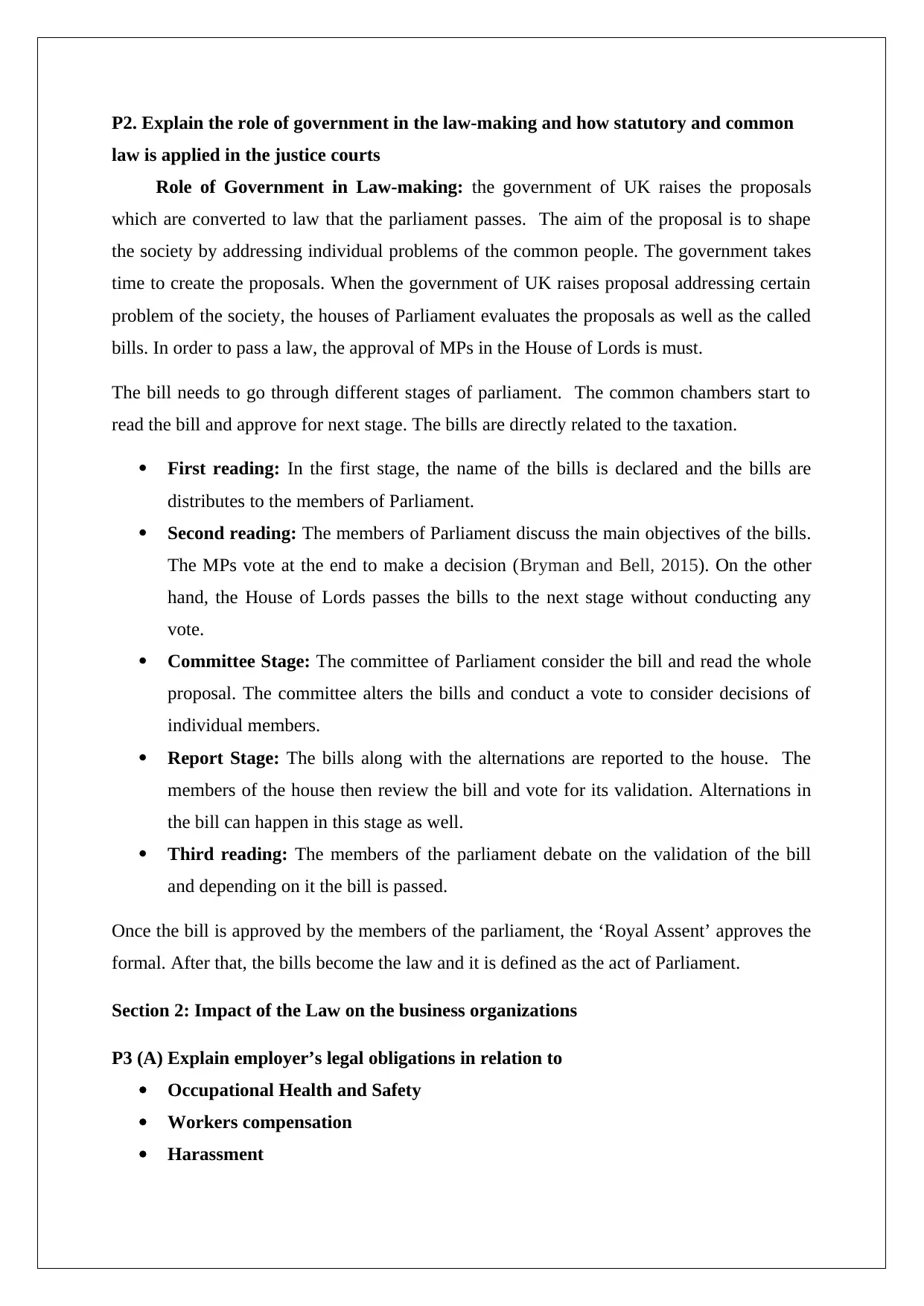
P2. Explain the role of government in the law-making and how statutory and common
law is applied in the justice courts
Role of Government in Law-making: the government of UK raises the proposals
which are converted to law that the parliament passes. The aim of the proposal is to shape
the society by addressing individual problems of the common people. The government takes
time to create the proposals. When the government of UK raises proposal addressing certain
problem of the society, the houses of Parliament evaluates the proposals as well as the called
bills. In order to pass a law, the approval of MPs in the House of Lords is must.
The bill needs to go through different stages of parliament. The common chambers start to
read the bill and approve for next stage. The bills are directly related to the taxation.
First reading: In the first stage, the name of the bills is declared and the bills are
distributes to the members of Parliament.
Second reading: The members of Parliament discuss the main objectives of the bills.
The MPs vote at the end to make a decision (Bryman and Bell, 2015). On the other
hand, the House of Lords passes the bills to the next stage without conducting any
vote.
Committee Stage: The committee of Parliament consider the bill and read the whole
proposal. The committee alters the bills and conduct a vote to consider decisions of
individual members.
Report Stage: The bills along with the alternations are reported to the house. The
members of the house then review the bill and vote for its validation. Alternations in
the bill can happen in this stage as well.
Third reading: The members of the parliament debate on the validation of the bill
and depending on it the bill is passed.
Once the bill is approved by the members of the parliament, the ‘Royal Assent’ approves the
formal. After that, the bills become the law and it is defined as the act of Parliament.
Section 2: Impact of the Law on the business organizations
P3 (A) Explain employer’s legal obligations in relation to
Occupational Health and Safety
Workers compensation
Harassment
law is applied in the justice courts
Role of Government in Law-making: the government of UK raises the proposals
which are converted to law that the parliament passes. The aim of the proposal is to shape
the society by addressing individual problems of the common people. The government takes
time to create the proposals. When the government of UK raises proposal addressing certain
problem of the society, the houses of Parliament evaluates the proposals as well as the called
bills. In order to pass a law, the approval of MPs in the House of Lords is must.
The bill needs to go through different stages of parliament. The common chambers start to
read the bill and approve for next stage. The bills are directly related to the taxation.
First reading: In the first stage, the name of the bills is declared and the bills are
distributes to the members of Parliament.
Second reading: The members of Parliament discuss the main objectives of the bills.
The MPs vote at the end to make a decision (Bryman and Bell, 2015). On the other
hand, the House of Lords passes the bills to the next stage without conducting any
vote.
Committee Stage: The committee of Parliament consider the bill and read the whole
proposal. The committee alters the bills and conduct a vote to consider decisions of
individual members.
Report Stage: The bills along with the alternations are reported to the house. The
members of the house then review the bill and vote for its validation. Alternations in
the bill can happen in this stage as well.
Third reading: The members of the parliament debate on the validation of the bill
and depending on it the bill is passed.
Once the bill is approved by the members of the parliament, the ‘Royal Assent’ approves the
formal. After that, the bills become the law and it is defined as the act of Parliament.
Section 2: Impact of the Law on the business organizations
P3 (A) Explain employer’s legal obligations in relation to
Occupational Health and Safety
Workers compensation
Harassment
⊘ This is a preview!⊘
Do you want full access?
Subscribe today to unlock all pages.

Trusted by 1+ million students worldwide
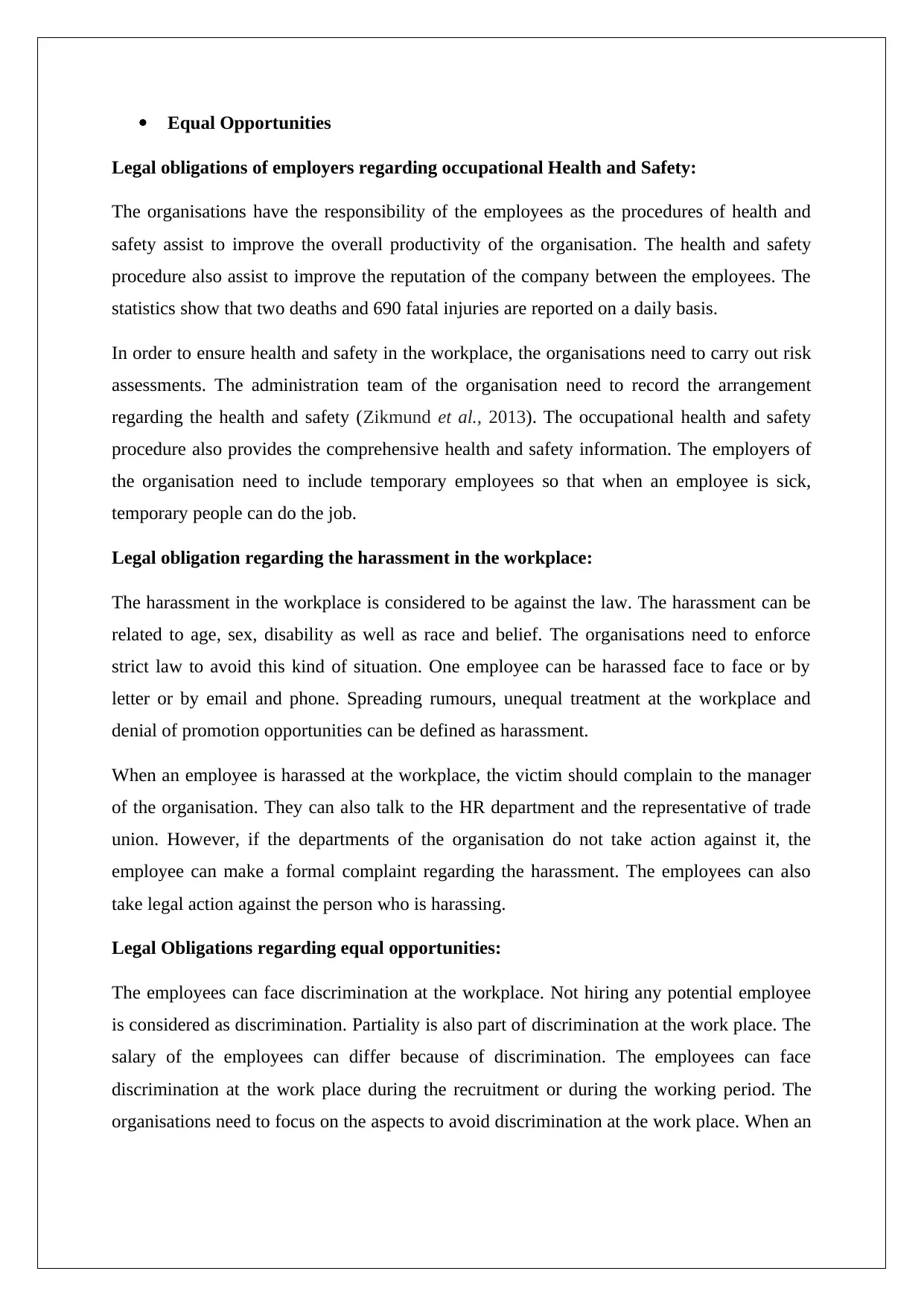
Equal Opportunities
Legal obligations of employers regarding occupational Health and Safety:
The organisations have the responsibility of the employees as the procedures of health and
safety assist to improve the overall productivity of the organisation. The health and safety
procedure also assist to improve the reputation of the company between the employees. The
statistics show that two deaths and 690 fatal injuries are reported on a daily basis.
In order to ensure health and safety in the workplace, the organisations need to carry out risk
assessments. The administration team of the organisation need to record the arrangement
regarding the health and safety (Zikmund et al., 2013). The occupational health and safety
procedure also provides the comprehensive health and safety information. The employers of
the organisation need to include temporary employees so that when an employee is sick,
temporary people can do the job.
Legal obligation regarding the harassment in the workplace:
The harassment in the workplace is considered to be against the law. The harassment can be
related to age, sex, disability as well as race and belief. The organisations need to enforce
strict law to avoid this kind of situation. One employee can be harassed face to face or by
letter or by email and phone. Spreading rumours, unequal treatment at the workplace and
denial of promotion opportunities can be defined as harassment.
When an employee is harassed at the workplace, the victim should complain to the manager
of the organisation. They can also talk to the HR department and the representative of trade
union. However, if the departments of the organisation do not take action against it, the
employee can make a formal complaint regarding the harassment. The employees can also
take legal action against the person who is harassing.
Legal Obligations regarding equal opportunities:
The employees can face discrimination at the workplace. Not hiring any potential employee
is considered as discrimination. Partiality is also part of discrimination at the work place. The
salary of the employees can differ because of discrimination. The employees can face
discrimination at the work place during the recruitment or during the working period. The
organisations need to focus on the aspects to avoid discrimination at the work place. When an
Legal obligations of employers regarding occupational Health and Safety:
The organisations have the responsibility of the employees as the procedures of health and
safety assist to improve the overall productivity of the organisation. The health and safety
procedure also assist to improve the reputation of the company between the employees. The
statistics show that two deaths and 690 fatal injuries are reported on a daily basis.
In order to ensure health and safety in the workplace, the organisations need to carry out risk
assessments. The administration team of the organisation need to record the arrangement
regarding the health and safety (Zikmund et al., 2013). The occupational health and safety
procedure also provides the comprehensive health and safety information. The employers of
the organisation need to include temporary employees so that when an employee is sick,
temporary people can do the job.
Legal obligation regarding the harassment in the workplace:
The harassment in the workplace is considered to be against the law. The harassment can be
related to age, sex, disability as well as race and belief. The organisations need to enforce
strict law to avoid this kind of situation. One employee can be harassed face to face or by
letter or by email and phone. Spreading rumours, unequal treatment at the workplace and
denial of promotion opportunities can be defined as harassment.
When an employee is harassed at the workplace, the victim should complain to the manager
of the organisation. They can also talk to the HR department and the representative of trade
union. However, if the departments of the organisation do not take action against it, the
employee can make a formal complaint regarding the harassment. The employees can also
take legal action against the person who is harassing.
Legal Obligations regarding equal opportunities:
The employees can face discrimination at the workplace. Not hiring any potential employee
is considered as discrimination. Partiality is also part of discrimination at the work place. The
salary of the employees can differ because of discrimination. The employees can face
discrimination at the work place during the recruitment or during the working period. The
organisations need to focus on the aspects to avoid discrimination at the work place. When an
Paraphrase This Document
Need a fresh take? Get an instant paraphrase of this document with our AI Paraphraser

employee is discriminated within the organisation, the administration team should take
actions to overcome the situation. The laws need to be applied according to the situation.
Legal Obligations regarding Workers compensation:
The organisations need to provide workers compensation that includes life insurance of the
employees. The public organisations need to apply law for workers compensation. The
organisation is responsible for the health security of the people (Leung et al., 2013). The
health and safety procedure also assist to improve the reputation of the company between the
employees. In order to overcome any uncanny situation, the organisations provide life
insurance to the employees as well as their family. Maximum organisations provide maternity
leave for pregnant women. They also provide money for the people for relocation.
P3 (B) Explain the relevant employment and contract law that will have potential
impact on the business in the case study
The prevention of accidents is recognized key indicators of Public Health Outcomes
Frameworks of 2013-2016. There are three published leadership information from NICE or
the National Institute for Health and Care Excellence outline suggestion for all these with
different strategic position to play in accident prevention, including CCG or Clinical
Commissioning Groups, their partners and local authorities. Unlike safeguarding, currently
there are no needs for principal healthcare teams in order to undergo guidance in
unintentional accidents prevention. This is also one of key recommendation of NICE
guidance.
According to the case study, that 16 year old girl unfortunately burnt her left hand
badly and this scenario is some extend relevant to contract law and employment. Additionally
this law also provide different concepts of accident prevention.
Primary Prevention: Removal of situations cause injury such as reduction of traffic
speed, fitting stair gate for all young children, reduces alcohol consumption.
Secondary Prevention: Reduce brutality of injury can also cause accidents such as
bicycle helmets, car seat belts, smoke alarms.
Tertiary Prevention: Rehabilitation and optimal treatment following injuries such as
appropriate hospital service, efficient first aid.
actions to overcome the situation. The laws need to be applied according to the situation.
Legal Obligations regarding Workers compensation:
The organisations need to provide workers compensation that includes life insurance of the
employees. The public organisations need to apply law for workers compensation. The
organisation is responsible for the health security of the people (Leung et al., 2013). The
health and safety procedure also assist to improve the reputation of the company between the
employees. In order to overcome any uncanny situation, the organisations provide life
insurance to the employees as well as their family. Maximum organisations provide maternity
leave for pregnant women. They also provide money for the people for relocation.
P3 (B) Explain the relevant employment and contract law that will have potential
impact on the business in the case study
The prevention of accidents is recognized key indicators of Public Health Outcomes
Frameworks of 2013-2016. There are three published leadership information from NICE or
the National Institute for Health and Care Excellence outline suggestion for all these with
different strategic position to play in accident prevention, including CCG or Clinical
Commissioning Groups, their partners and local authorities. Unlike safeguarding, currently
there are no needs for principal healthcare teams in order to undergo guidance in
unintentional accidents prevention. This is also one of key recommendation of NICE
guidance.
According to the case study, that 16 year old girl unfortunately burnt her left hand
badly and this scenario is some extend relevant to contract law and employment. Additionally
this law also provide different concepts of accident prevention.
Primary Prevention: Removal of situations cause injury such as reduction of traffic
speed, fitting stair gate for all young children, reduces alcohol consumption.
Secondary Prevention: Reduce brutality of injury can also cause accidents such as
bicycle helmets, car seat belts, smoke alarms.
Tertiary Prevention: Rehabilitation and optimal treatment following injuries such as
appropriate hospital service, efficient first aid.
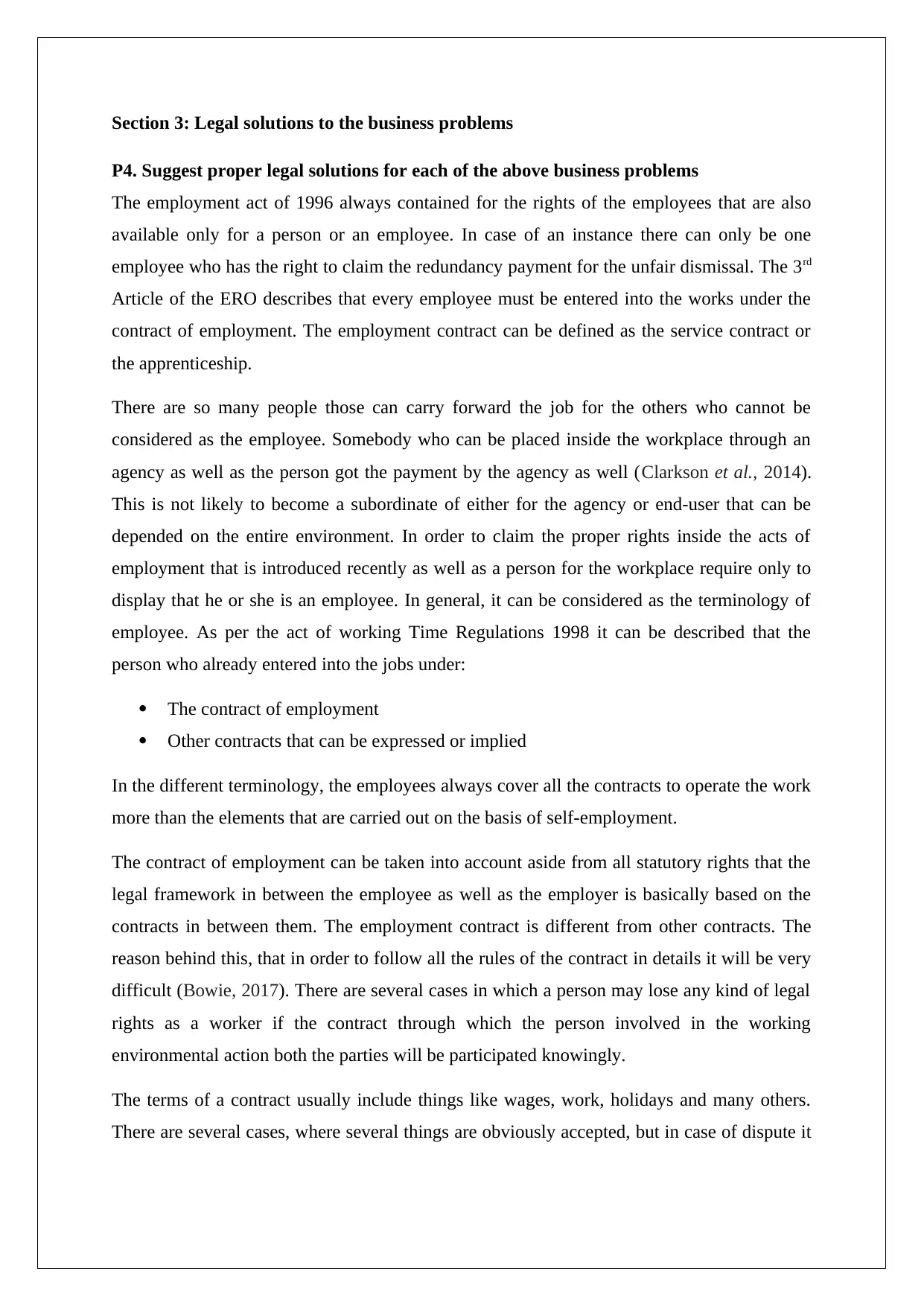
Section 3: Legal solutions to the business problems
P4. Suggest proper legal solutions for each of the above business problems
The employment act of 1996 always contained for the rights of the employees that are also
available only for a person or an employee. In case of an instance there can only be one
employee who has the right to claim the redundancy payment for the unfair dismissal. The 3rd
Article of the ERO describes that every employee must be entered into the works under the
contract of employment. The employment contract can be defined as the service contract or
the apprenticeship.
There are so many people those can carry forward the job for the others who cannot be
considered as the employee. Somebody who can be placed inside the workplace through an
agency as well as the person got the payment by the agency as well (Clarkson et al., 2014).
This is not likely to become a subordinate of either for the agency or end-user that can be
depended on the entire environment. In order to claim the proper rights inside the acts of
employment that is introduced recently as well as a person for the workplace require only to
display that he or she is an employee. In general, it can be considered as the terminology of
employee. As per the act of working Time Regulations 1998 it can be described that the
person who already entered into the jobs under:
The contract of employment
Other contracts that can be expressed or implied
In the different terminology, the employees always cover all the contracts to operate the work
more than the elements that are carried out on the basis of self-employment.
The contract of employment can be taken into account aside from all statutory rights that the
legal framework in between the employee as well as the employer is basically based on the
contracts in between them. The employment contract is different from other contracts. The
reason behind this, that in order to follow all the rules of the contract in details it will be very
difficult (Bowie, 2017). There are several cases in which a person may lose any kind of legal
rights as a worker if the contract through which the person involved in the working
environmental action both the parties will be participated knowingly.
The terms of a contract usually include things like wages, work, holidays and many others.
There are several cases, where several things are obviously accepted, but in case of dispute it
P4. Suggest proper legal solutions for each of the above business problems
The employment act of 1996 always contained for the rights of the employees that are also
available only for a person or an employee. In case of an instance there can only be one
employee who has the right to claim the redundancy payment for the unfair dismissal. The 3rd
Article of the ERO describes that every employee must be entered into the works under the
contract of employment. The employment contract can be defined as the service contract or
the apprenticeship.
There are so many people those can carry forward the job for the others who cannot be
considered as the employee. Somebody who can be placed inside the workplace through an
agency as well as the person got the payment by the agency as well (Clarkson et al., 2014).
This is not likely to become a subordinate of either for the agency or end-user that can be
depended on the entire environment. In order to claim the proper rights inside the acts of
employment that is introduced recently as well as a person for the workplace require only to
display that he or she is an employee. In general, it can be considered as the terminology of
employee. As per the act of working Time Regulations 1998 it can be described that the
person who already entered into the jobs under:
The contract of employment
Other contracts that can be expressed or implied
In the different terminology, the employees always cover all the contracts to operate the work
more than the elements that are carried out on the basis of self-employment.
The contract of employment can be taken into account aside from all statutory rights that the
legal framework in between the employee as well as the employer is basically based on the
contracts in between them. The employment contract is different from other contracts. The
reason behind this, that in order to follow all the rules of the contract in details it will be very
difficult (Bowie, 2017). There are several cases in which a person may lose any kind of legal
rights as a worker if the contract through which the person involved in the working
environmental action both the parties will be participated knowingly.
The terms of a contract usually include things like wages, work, holidays and many others.
There are several cases, where several things are obviously accepted, but in case of dispute it
⊘ This is a preview!⊘
Do you want full access?
Subscribe today to unlock all pages.

Trusted by 1+ million students worldwide
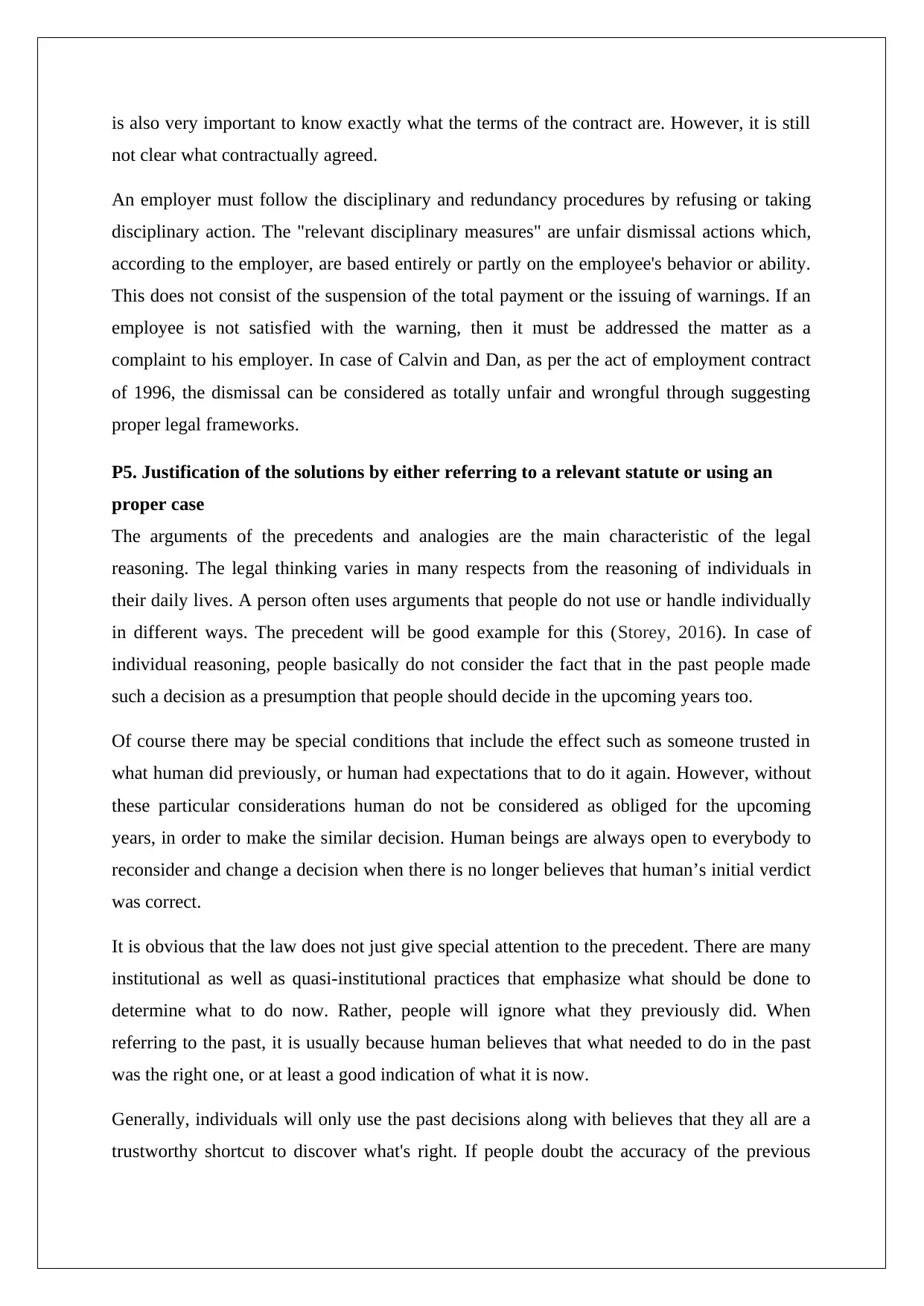
is also very important to know exactly what the terms of the contract are. However, it is still
not clear what contractually agreed.
An employer must follow the disciplinary and redundancy procedures by refusing or taking
disciplinary action. The "relevant disciplinary measures" are unfair dismissal actions which,
according to the employer, are based entirely or partly on the employee's behavior or ability.
This does not consist of the suspension of the total payment or the issuing of warnings. If an
employee is not satisfied with the warning, then it must be addressed the matter as a
complaint to his employer. In case of Calvin and Dan, as per the act of employment contract
of 1996, the dismissal can be considered as totally unfair and wrongful through suggesting
proper legal frameworks.
P5. Justification of the solutions by either referring to a relevant statute or using an
proper case
The arguments of the precedents and analogies are the main characteristic of the legal
reasoning. The legal thinking varies in many respects from the reasoning of individuals in
their daily lives. A person often uses arguments that people do not use or handle individually
in different ways. The precedent will be good example for this (Storey, 2016). In case of
individual reasoning, people basically do not consider the fact that in the past people made
such a decision as a presumption that people should decide in the upcoming years too.
Of course there may be special conditions that include the effect such as someone trusted in
what human did previously, or human had expectations that to do it again. However, without
these particular considerations human do not be considered as obliged for the upcoming
years, in order to make the similar decision. Human beings are always open to everybody to
reconsider and change a decision when there is no longer believes that human’s initial verdict
was correct.
It is obvious that the law does not just give special attention to the precedent. There are many
institutional as well as quasi-institutional practices that emphasize what should be done to
determine what to do now. Rather, people will ignore what they previously did. When
referring to the past, it is usually because human believes that what needed to do in the past
was the right one, or at least a good indication of what it is now.
Generally, individuals will only use the past decisions along with believes that they all are a
trustworthy shortcut to discover what's right. If people doubt the accuracy of the previous
not clear what contractually agreed.
An employer must follow the disciplinary and redundancy procedures by refusing or taking
disciplinary action. The "relevant disciplinary measures" are unfair dismissal actions which,
according to the employer, are based entirely or partly on the employee's behavior or ability.
This does not consist of the suspension of the total payment or the issuing of warnings. If an
employee is not satisfied with the warning, then it must be addressed the matter as a
complaint to his employer. In case of Calvin and Dan, as per the act of employment contract
of 1996, the dismissal can be considered as totally unfair and wrongful through suggesting
proper legal frameworks.
P5. Justification of the solutions by either referring to a relevant statute or using an
proper case
The arguments of the precedents and analogies are the main characteristic of the legal
reasoning. The legal thinking varies in many respects from the reasoning of individuals in
their daily lives. A person often uses arguments that people do not use or handle individually
in different ways. The precedent will be good example for this (Storey, 2016). In case of
individual reasoning, people basically do not consider the fact that in the past people made
such a decision as a presumption that people should decide in the upcoming years too.
Of course there may be special conditions that include the effect such as someone trusted in
what human did previously, or human had expectations that to do it again. However, without
these particular considerations human do not be considered as obliged for the upcoming
years, in order to make the similar decision. Human beings are always open to everybody to
reconsider and change a decision when there is no longer believes that human’s initial verdict
was correct.
It is obvious that the law does not just give special attention to the precedent. There are many
institutional as well as quasi-institutional practices that emphasize what should be done to
determine what to do now. Rather, people will ignore what they previously did. When
referring to the past, it is usually because human believes that what needed to do in the past
was the right one, or at least a good indication of what it is now.
Generally, individuals will only use the past decisions along with believes that they all are a
trustworthy shortcut to discover what's right. If people doubt the accuracy of the previous
Paraphrase This Document
Need a fresh take? Get an instant paraphrase of this document with our AI Paraphraser

decision, they will reopen the case and review it again. Institutional decision-makers, on the
contrary, often limit what has been decided in the past to limit what needs to be done.
Legal considerations give proper weight to what had been decided in the previous years, the
weight basically lacking in personal decision-making. It is important for us if people have
made the right decisions in his or her past, but now people are trying to make the right
decisions without harming our previous views. In order to claim the proper rights inside the
acts of employment that is introduced recently as well as a person for the workplace require
only to display that he or she is an employee. In case of Calvin and Dan the dismissal can be
considered as totally unfair and wrongful through suggesting proper legal frameworks. The
employment contract is different from other contracts. The reason behind this, that in order to
follow all the rules of the contract in details it will be very difficult.
M3. Assess the positive and negative impacts of the legal solutions to the business
problems
According to this objection, the judges will more and more define the welfare state's account
in the application of the constitution as the source for the positive obligations. Therefore there
is as well as should be a clear distinction and separation between the laws and policies
(Myers, 2013). In order to extent that the positive obligations for the present state that are
identified, its application is a political problem that requires to be taken into account in the
political field, where controversial distribution decisions may be created inside the channels
of the majority policy.
For example, the influential tradition of German ordo-liberalism has interfered with Europe's
argument that it is the task of the new European trade law to implement and protect a system
of open markets and to ensure uncontrolled competition at supranational constitutional level
outside the state. The Member States must have these legislative powers in terms of
maintaining social compatibility compatible with open markets. A closely linked project
regrets the progressive replacement of a private law which is unquestionably necessary,
without the aim, as a purely legal form and as a bulwark of freedom by a law of public
subordination.
contrary, often limit what has been decided in the past to limit what needs to be done.
Legal considerations give proper weight to what had been decided in the previous years, the
weight basically lacking in personal decision-making. It is important for us if people have
made the right decisions in his or her past, but now people are trying to make the right
decisions without harming our previous views. In order to claim the proper rights inside the
acts of employment that is introduced recently as well as a person for the workplace require
only to display that he or she is an employee. In case of Calvin and Dan the dismissal can be
considered as totally unfair and wrongful through suggesting proper legal frameworks. The
employment contract is different from other contracts. The reason behind this, that in order to
follow all the rules of the contract in details it will be very difficult.
M3. Assess the positive and negative impacts of the legal solutions to the business
problems
According to this objection, the judges will more and more define the welfare state's account
in the application of the constitution as the source for the positive obligations. Therefore there
is as well as should be a clear distinction and separation between the laws and policies
(Myers, 2013). In order to extent that the positive obligations for the present state that are
identified, its application is a political problem that requires to be taken into account in the
political field, where controversial distribution decisions may be created inside the channels
of the majority policy.
For example, the influential tradition of German ordo-liberalism has interfered with Europe's
argument that it is the task of the new European trade law to implement and protect a system
of open markets and to ensure uncontrolled competition at supranational constitutional level
outside the state. The Member States must have these legislative powers in terms of
maintaining social compatibility compatible with open markets. A closely linked project
regrets the progressive replacement of a private law which is unquestionably necessary,
without the aim, as a purely legal form and as a bulwark of freedom by a law of public
subordination.
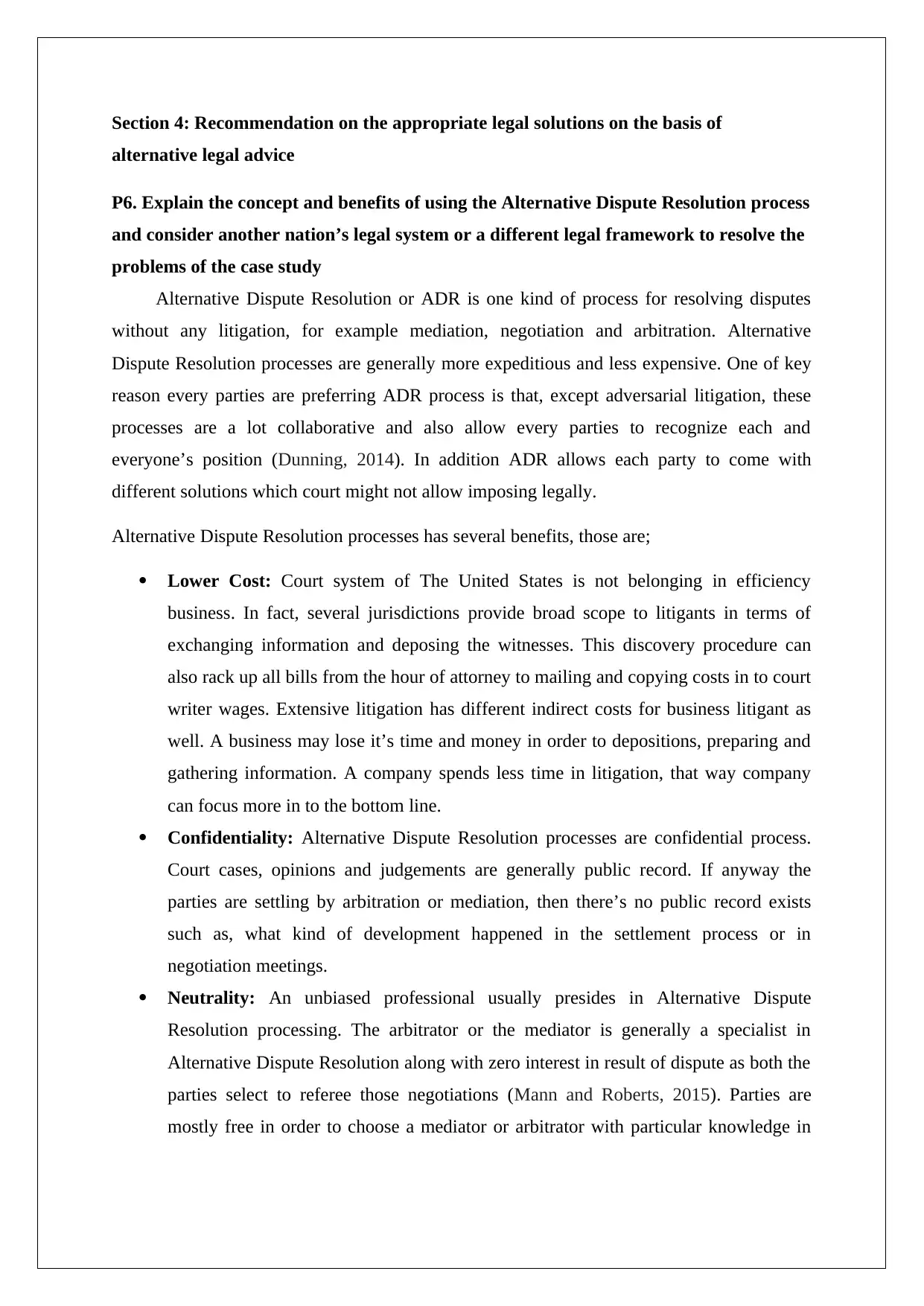
Section 4: Recommendation on the appropriate legal solutions on the basis of
alternative legal advice
P6. Explain the concept and benefits of using the Alternative Dispute Resolution process
and consider another nation’s legal system or a different legal framework to resolve the
problems of the case study
Alternative Dispute Resolution or ADR is one kind of process for resolving disputes
without any litigation, for example mediation, negotiation and arbitration. Alternative
Dispute Resolution processes are generally more expeditious and less expensive. One of key
reason every parties are preferring ADR process is that, except adversarial litigation, these
processes are a lot collaborative and also allow every parties to recognize each and
everyone’s position (Dunning, 2014). In addition ADR allows each party to come with
different solutions which court might not allow imposing legally.
Alternative Dispute Resolution processes has several benefits, those are;
Lower Cost: Court system of The United States is not belonging in efficiency
business. In fact, several jurisdictions provide broad scope to litigants in terms of
exchanging information and deposing the witnesses. This discovery procedure can
also rack up all bills from the hour of attorney to mailing and copying costs in to court
writer wages. Extensive litigation has different indirect costs for business litigant as
well. A business may lose it’s time and money in order to depositions, preparing and
gathering information. A company spends less time in litigation, that way company
can focus more in to the bottom line.
Confidentiality: Alternative Dispute Resolution processes are confidential process.
Court cases, opinions and judgements are generally public record. If anyway the
parties are settling by arbitration or mediation, then there’s no public record exists
such as, what kind of development happened in the settlement process or in
negotiation meetings.
Neutrality: An unbiased professional usually presides in Alternative Dispute
Resolution processing. The arbitrator or the mediator is generally a specialist in
Alternative Dispute Resolution along with zero interest in result of dispute as both the
parties select to referee those negotiations (Mann and Roberts, 2015). Parties are
mostly free in order to choose a mediator or arbitrator with particular knowledge in
alternative legal advice
P6. Explain the concept and benefits of using the Alternative Dispute Resolution process
and consider another nation’s legal system or a different legal framework to resolve the
problems of the case study
Alternative Dispute Resolution or ADR is one kind of process for resolving disputes
without any litigation, for example mediation, negotiation and arbitration. Alternative
Dispute Resolution processes are generally more expeditious and less expensive. One of key
reason every parties are preferring ADR process is that, except adversarial litigation, these
processes are a lot collaborative and also allow every parties to recognize each and
everyone’s position (Dunning, 2014). In addition ADR allows each party to come with
different solutions which court might not allow imposing legally.
Alternative Dispute Resolution processes has several benefits, those are;
Lower Cost: Court system of The United States is not belonging in efficiency
business. In fact, several jurisdictions provide broad scope to litigants in terms of
exchanging information and deposing the witnesses. This discovery procedure can
also rack up all bills from the hour of attorney to mailing and copying costs in to court
writer wages. Extensive litigation has different indirect costs for business litigant as
well. A business may lose it’s time and money in order to depositions, preparing and
gathering information. A company spends less time in litigation, that way company
can focus more in to the bottom line.
Confidentiality: Alternative Dispute Resolution processes are confidential process.
Court cases, opinions and judgements are generally public record. If anyway the
parties are settling by arbitration or mediation, then there’s no public record exists
such as, what kind of development happened in the settlement process or in
negotiation meetings.
Neutrality: An unbiased professional usually presides in Alternative Dispute
Resolution processing. The arbitrator or the mediator is generally a specialist in
Alternative Dispute Resolution along with zero interest in result of dispute as both the
parties select to referee those negotiations (Mann and Roberts, 2015). Parties are
mostly free in order to choose a mediator or arbitrator with particular knowledge in
⊘ This is a preview!⊘
Do you want full access?
Subscribe today to unlock all pages.

Trusted by 1+ million students worldwide
1 out of 18
Related Documents
Your All-in-One AI-Powered Toolkit for Academic Success.
+13062052269
info@desklib.com
Available 24*7 on WhatsApp / Email
![[object Object]](/_next/static/media/star-bottom.7253800d.svg)
Unlock your academic potential
Copyright © 2020–2025 A2Z Services. All Rights Reserved. Developed and managed by ZUCOL.





